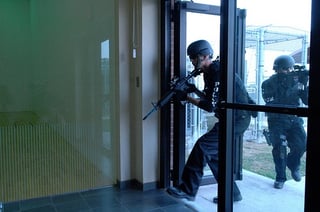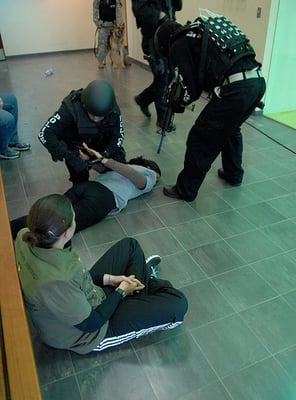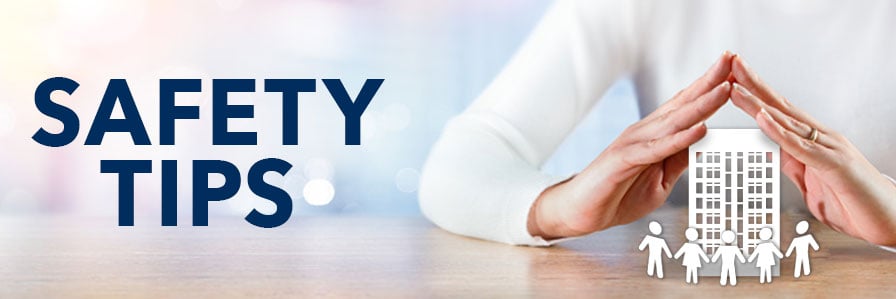Real Active Shooter Incidents
On April 6, 2007, a single gunman perpetrated the Virginia Tech massacre, and murdered thirty-two people and injured an additional seventeen before committing suicide. The Virginia Tech massacre was the deadliest shooting incident by a single gunman and demonstrated just how dangerous a single active shooter can be.
On June 12, 2016, forty-nine people were killed and an additional fifty-three were wounded in a nightclub in Orlando, Florida. Police shot and killed the gunman after a three hour standoff.
On the night of October 1, 2017, a gunman in Las Vegas opened fire on a crowd of concert attendees from his hotel room. Fifty-eight people were killed and 413 were wounded. The ensuing panic brought the total number of injured to 869. The shooter was found dead in his room and his motive was never able to be determined.
On December 14, 2012, twenty first graders and six adults were shot and killed during the Sandy Hook Elementary School shooting. A lone perpetrator forced his way into the school and began shooting at children and faculty before police arrived and he turned the gun on himself.
These are just a few of the numerous active shooter instances that occur every year in the United States. The places in the examples above are places most people typically feel safe and would never expect someone to suddenly start shooting people.  Active shooter incidents are difficult to predict since they often occur without warning and are typically over within minutes. There are, however, ways you can help prepare your organization for an event like this and potentially save lives.
Active shooter incidents are difficult to predict since they often occur without warning and are typically over within minutes. There are, however, ways you can help prepare your organization for an event like this and potentially save lives.
What is an Active Shooter?
The term active shooter began to be used in the wake of the Columbine High School Massacre and has since been used to describe instances like those mentioned above. The United States Department of Homeland Security describes an active shooter as “an individual actively engaged in killing or attempting to kill people in a confined space or other populated area. In most cases, active shooters use firearms and there is no pattern or method to their selection of victims.”
Responding to an Active Shooter
Since active shooter situations develop so quickly and provide little or no warning, it is difficult to prepare for them, but developing a plan for your organization and practicing it can make a difference in saving lives until law enforcement arrives.
The Best Option – Evacuate
The best option in an active shooter scenario is to flee the premises and remove yourself from the shooter’s path. Unfortunately, this is not always a viable option as escaping could put you in greater danger if it brings you closer to the shooter. There are a few precautions you should take if, after assessing the situation, you determine you can safely evacuate. You should:
- Call 911 if you can do so safely.
- Warn any individuals you encounter to not enter the area.
- Leave your personal belongings behind.
- Have your escape route planned in your mind.
- Resist the urge to move or evacuate wounded people.
- If possible, assist other able-bodied people in fleeing.
- Comply with all law enforcement requests.
- Keep your hands visible and your fingers spread.
Next Best Option – Hide
If you are unable to safely evacuate the path of an active shooter your next best option is to hide, avoid detection, and wait for law enforcement to arrive. While hiding is not as effective as evacuation, it can usually keep you safe long enough for law enforcement to arrive. Hiding can be dangerous though as it can leave you trapped if the shooter were to discover your location. To ensure your hiding spot is as safe as possible please consider the following recommendations:
- Remain silent and still.
- Silence your cell phone and other electronic devices.
- If possible, lock the door to whatever room or closet you are hiding in. Do not unlock the door for anyone at any time. Tell the police that you will wait for them to retrieve a key to the room.
- Blockade the door with heavy furniture.
- Make sure you remain out of the shooter’s view.
- Stay away from any windows.
- If the windows are equipped with curtains, close them.
- Remain low and attempt to find cover under furniture or other objects.
- Do not leave your hiding place until you are absolutely certain law enforcement has arrived.
Last Resort – Fight Back
Occasionally, in active shooter situations, evacuation and hiding are not available options and you may find yourself face-to-face with the shooter. If you find yourself in this situation, your only remaining option is to take physical action against the shooter in hopes of incapacitating them or disarming them. This should be considered an extreme last resort, but if you decide attacking the shooter is your only option consider the following strategies:
- Act quickly; hesitation could get you killed.
- Throw items to distract, disorient, or disarm the shooter.
- Yell and wave your arms to startle the shooter.
Working with Emergency Responders
What to Report to 911 or First Responders
Active shooter situations are extremely frantic and are often over in a manner of minutes. Cooperating with law enforcement and emergency response personnel can prove critical in stopping the perpetrator and saving lives. If you are able to safely call 911, or if you safely evacuate and make contact with first responders, the information you provide is extremely important.
Do your best to provide the following information:
- The number of shooters
- Location of shooter(s)
- The number of potential victims
- Physical description of the shooter(s), including gender, clothing, height, weight, hair color, etc.
- The amount and types of weapons used by the perpetrator(s)
First Responders’ Roles
 Law enforcement is trained to locate and stop the shooter above all else. This means they will not stop to treat or help evacuate any injured people. They will also not escort people out of the building until they have identified and stopped the shooter. This means if you are in a concealed area, remain there until law enforcement personnel indicate that the shooter is apprehended or killed.
Law enforcement is trained to locate and stop the shooter above all else. This means they will not stop to treat or help evacuate any injured people. They will also not escort people out of the building until they have identified and stopped the shooter. This means if you are in a concealed area, remain there until law enforcement personnel indicate that the shooter is apprehended or killed.
Reacting to First Responders
Law enforcement will attempt to eliminate the threat quickly, so it is important to comply with all of their demands and do not attempt to interfere in any capacity even if you think you are being helpful. To best comply with law enforcement and enable them to do their job safely and effectively do the following:
- Follow instructions immediately.
- Remain calm.
- Carry nothing in your hands.
- Keep your hands visible at all times.
- Keep your fingers spread.
- Never make any sudden movements.
- Do not ask for help or medical assistance, there will be responders outside waiting to perform this task.
- Do not ask for directions on how to evacuate they will either tell you or simply proceed from the area they came from.
Another key issue to consider when reacting to first responders is that an incident like an active shooter may involve more than uniformed police officers you are accustomed to seeing. Some may be in SWAT gear and others may be in plain clothes so it is important to respond cautiously to anyone claiming to be law enforcement until you are sure they are in fact law enforcement personnel.
Develop an Emergency Action Plan
Developing an Emergency Active Plan is essential in protecting staff and guests in the event an active shooter enters your facility. Every organization’s Emergency Action Plan will be different based on the nature of the organization as well as the design of the building, but certain components will be the same for everyone.
Your plan should detail each individual’s responsibilities in the event of an emergency and should be updated regularly to ensure all staff is up to speed. In addition, all evacuation routes detailed in the plan should be checked regularly to ensure they are still viable and nothing is obstructing them. Some key components to consider in your organization’s Emergency Action Plan include:
- Evacuation procedures and routes: should vary depending on each location/area within your facility
- Route assignments: The way certain people should escape depending on the area of the facility they are most likely to be
- Floor plans: To help people better understand their best escape routes
- List of exits: Make sure to check each exit to verify it is well marked
- Safe areas: Areas that can be used to safely hide during an active shooter situation
- Notification systems: How employees and guests will be alerted to an active shooter situation
- Contact information: Include law enforcement, fire and rescue, local hospitals and more
- Methods for reporting emergencies to these emergency personnel and who should be responsible for contacting them
Another key consideration when developing your Emergency Action Plan is to accommodate for any employees or guests that may have disabilities or limitations. It is important to place people with restrictions in areas where they would be able to evacuate in the event an active shooter enters your organization.
Preparing for an Active Shooter
Creating an Emergency Action Plan is an important step in protecting your organization from an active shooter, but it is only effective if you train your employees on how to implement the plan in the event an active shooter situation arises. The best way to prepare employees for active shooter situations is to conduct active shooter drills. These drills will allow every employee to act out their roles and ensure they know what to do in the event of a real-life active shooter situation. Make sure all employees are trained in the following:
- Recognizing an active shooter or the sounds of an active shooter.
- Knowing how to respond to an active shooter or sounds of an active shooter. This means they should all know how to:
- Safely evacuate their area.
- Safely hide to avoid detection.
- Fight back as effectively as possible.
- Contact emergency personnel.
- Recognize and cooperate with emergency responders.
- Give all employees copies of your facility’s Emergency Action Plan along with maps highlighting escape routes and potential secure areas to hide.
- Provide emergency contact information for those employees identified as ones to contact authorities.
Coordinating with Local Authorities
Another great way to ensure your employees are well trained and that your Emergency Action Plan is as effective as possible is to contact local authorities. Law enforcement personnel will be able to help develop a plan and may be available to help conduct drills. It is recommended that before conducting any active shooter drill that all employees, guests, local law enforcement and anyone else who may be in or near your facility are made aware of the drill as to avoid any potential panic or miscommunication.
Additional Active Shooter Resources
Interested in more information and tools to help prepare for an active shooter situation? Here are some tools from other organizations that we found helpful:




